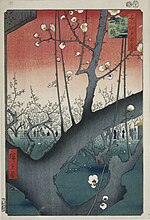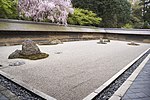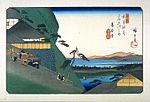Edo meisho zue (江戸名所図会, "Guide to famous Edo sites") is an illustrated guide describing famous places, called meisho, and depicting their scenery in pre-1868...
5 KB (589 words) - 21:13, 13 November 2023
One Hundred Famous Views of Edo (in Japanese: 名所江戸百景, romanized: Meisho Edo Hyakkei) is a series of 119 ukiyo-e prints begun and largely completed by...
71 KB (937 words) - 00:35, 30 July 2024
techniques in books divided among volumes. The Owari meisho Zue followed the publication of the Edo meisho zue, which sparked a public interest in travel guides...
2 KB (98 words) - 15:27, 28 March 2024
with names such as Edo meisho zue (Illustrated famous Edo places, 1834) and Owari meisho zue (Illustrated famous Owari places). Meisho also provided a popular...
4 KB (542 words) - 15:33, 26 July 2024
Japanese literature (redirect from Edo literary works)
Issa (1763–1828) Jippensha Ikku (1765–1831) Kyokutei Bakin (1767–1848) Edo Meisho Zue (travelogue, 1834) Hokuetsu Seppu (work of human geography, 1837) Nakane...
41 KB (4,900 words) - 03:26, 9 August 2024
found to actually borrow directly from other works such as the Tōkaidō meisho zue (東海道名所図会) from 1797. An example is the view of the station Ishibe „Megawa...
24 KB (1,618 words) - 14:12, 21 August 2024
the woodblocks for many ukiyo-e prints. The Edo meisho zue, an illustrated catalogue of the sights of Edo for which he provided in the woodcuts, is one...
3 KB (269 words) - 08:03, 8 June 2024
Kameido (ca. 1780/90) Kunitora: Kameido (ca. 1800) Kameido (Detail) aus Edo meisho zue (1838) Hiroshige: Kameido in Winter Hiroshige: Kameido frontside Photo...
5 KB (426 words) - 22:04, 12 November 2023
Yamakawa Shuppan, 2005, ISBN 978-4-634-24813-7. Saitō Gesshin u. a.: Edo meisho zue (江戸名所図会). Six volumes, 1834 to 1836. "Jindai-ji Official English page"...
4 KB (523 words) - 12:11, 18 November 2023
yet, as well as the view that in Hasegawa Settan's paintings in the Edo Meisho Zue, since tōfu sellers were depicted wearing kasa, that tōfu-kozō are the...
14 KB (1,779 words) - 15:42, 4 August 2024
published. These included Edo meisho zue by Gekisen Saito, Namiki Gohei's Edo shinbutsu ganken juhouki, and Okayama Tori's Edo meisho e kagarenki, which catalogued...
141 KB (20,087 words) - 19:57, 28 August 2024
Famous Views of the Sixty-odd Provinces (in Japanese 六十余州名所図会 Rokujūyoshū Meisho Zue) is a series of ukiyo-e prints by the Japanese artist Hiroshige (1797–1858)...
31 KB (723 words) - 19:08, 29 April 2024
the temple was thus depicted in the Edo meisho zue and other guidebooks as one of the major sightseeing spots of Edo. The temple town which developed surrounding...
7 KB (802 words) - 17:47, 2 October 2023
Commons has media related to Joshin-ji (Setagaya). Saito, Yukio (1997). Edo meisho zue. Yūhōdō bunko. pp. 127–133. ISBN 4-480-08338-3. Graham, Patricia J....
9 KB (918 words) - 10:52, 19 July 2024
did actually exist in the Heian Period, and in publications like the Edo meisho zue, he is written about under the name of "Tōkōbō Ajari Yūkei" (東光坊阿闍梨宥慶)...
28 KB (4,137 words) - 07:01, 14 July 2024
Ningyo (section Ningyo in Wakan sansai zue)
resembling the Western mermaid. (cf. § Ningyo in Wakan sansai zue) The Wakan sansai zue did also give notice and print the facsimile illustration of the...
116 KB (12,392 words) - 12:28, 31 August 2024
such old manuscripts as "Shinpen Musashi Fudoki-ko" 'Azamakagami" and "Edo Meisho Zue”. According to them, in 1193, Minamoto Yoritomo made a camp for lunch...
6 KB (645 words) - 11:38, 28 March 2022
Settsu Meisho Zue states that "the Nuezuka is between Ashiya River and Sumiyoshi River." According to the Ashiwake bune, a geography book from the Edo period...
16 KB (2,164 words) - 05:46, 25 July 2024
shrine and offered a Gohonzon and a sword to it. At the beginning of the Edo period, Tokugawa Ieyasu donated land worth fifty koku to the shrine. He is...
11 KB (1,074 words) - 16:16, 26 October 2023
Ninigi-no-Mikoto's descent. In the Sangoku Meisho Zue (三国名勝図会), a chronicle written by Satsuma Domain at the end of the Edo period, it is written that the name...
25 KB (2,973 words) - 00:12, 16 June 2024
(Bunsei 12). Daienji is now in Suginami, Tokyo; Edo Meisho Zue in 1836 (Tenpo 7). Hiroshigega Meisho Edo Hyakkei (広重画 名所江戸百景) Miyao Shigewo (宮尾しげを) Shueisha...
4 KB (419 words) - 14:09, 15 December 2023
Japan. Nagoya Castle was constructed by the Owari Domain in 1612 during the Edo period on the site of an earlier castle of the Oda clan in the Sengoku period...
81 KB (10,596 words) - 10:50, 19 August 2024
and spring. After New Year's, it becomes too salty to eat. The Owari meisho zue, published in the 19th century, contains illustrations of the monks featured...
13 KB (1,707 words) - 20:47, 28 July 2024
Hundred Views of Great Tokyo in the Showa Era" ((昭和東京百図絵, Shōwa Tōkyō hyaku zue") which was completed between 1928 and 1940. Austin Nihon no hanga Merritt...
7 KB (777 words) - 20:20, 25 August 2024
sword given by the Dragon King in the Wakan sansai zue encyclopedia (1712) and the Tōkaidō meisho zue [ja] almanac (1797). Hidesato's alleged armor from...
23 KB (2,416 words) - 06:51, 9 July 2024
(Tenryaku 6) and is exiled aged 19 in 956. According to Zenkōji michi meisho zue [ja] the ghost of Momiji became Hiyoshi Gongen (日吉権現) who protects Kitamuki...
8 KB (958 words) - 07:02, 14 July 2024
his garden in his Celebrated Gardens and Sights of Kyoto (Miyako rinsen meisho zue) of 1799, showing the garden as it looks today. One big stone at the back...
19 KB (2,360 words) - 03:59, 8 August 2024
Panoramic print view from the Owari meisho zue depicting the shrine complex in the late Edo period (1844)...
21 KB (2,221 words) - 22:07, 30 August 2024
province. The temple later fell on hard times and was renovated. In the early Edo period it was moved to the current location at the time of the construction...
6 KB (569 words) - 08:27, 24 July 2023
Hiroshige from an illustrated guide to the Nakasendō called the "Kisoji Meisho Zue", published in 1805. Nakasendō Banba-juku - Toriimoto-juku - Takamiya-juku...
9 KB (966 words) - 09:42, 6 August 2023



























